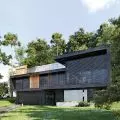Kinderspital Zürich,
Herzog & de Meuron
The new Zurich University Children's Hospital, designed by Herzog & de Meuron, is the largest pediatric facility in Switzerland, located in the Zürich-Lengg district at the foot of Burghölzli Hill. Consisting of a hospital emergency department and a research and teaching center, the project combines modern architecture with sustainable construction to create a space that promotes healing. Integrated elements, such as therapeutic gardens and play areas, support a holistic approach to care that considers the needs of both children and their families.
A modern building complex with wooden facades and green roofs surrounded by roads and trees, with the city skyline and mountains in the background
an interdisciplinary approach to treating children
The hospital's three-story concrete building, with fine wooden infills, blends in perfectly with the surrounding landscape. The interior is divided into zones, each dedicated to a different medical specialty. The main corridor, leading through each of the three floors, is surrounded by green courtyards, providing natural light. Patient rooms on the roof look like separate small houses.
Site plan showing a complex urban layout with buildings, roads and site contours
Lightweight building materials have been used throughout the building, with the exception of concrete supports and communication cores. This allows individual units to change their dimensions.
Floor plan with curved sides showing a series of rectangular rooms and circular elements
individualization of space in the research and teaching center
In the northern part of the site is a research and teaching center building with an open five-story atrium. Natural light floods into the interior, and thanks to movable walls the lecture halls, lobby and cafeteria can be transformed into one large space. It accommodates 670 people, with lecture halls, seminar rooms and student study areas designed in harmony with the natural terrain.
A modern, open interior space with wooden ceilings, large windows and minimalist furniture
therapeutic gardens as an element to promote healing
The entire complex is surrounded by 250 new trees, and boulders found during construction have been incorporated into its surroundings. The subterranean shape of the hospital's main building fits into the flat surroundings, offering views of the mountainous landscape in the background. An interdisciplinary and holistic approach to the design of the hospital complex was crucial to its perception as a place conducive to healing.
Modern wooden building with large windows, surrounded by greenery
Both buildings have received SGNI's platinum sustainable building certification, a testament to their green approach.
A garden with an abstract sculpture inside a modern wooden building
modern technology in pediatric diagnostics
The floors house laboratories and offices, offering panoramic views of the landscape. The spaces are designed to foster collaboration and knowledge exchange among researchers and students.
A hospital room with a metal crib surrounded by medical equipment and monitors
The two buildings, despite their different forms and functions, are complementary. The research center building, with its distinctive geometric architectural language, harmonizes with the flat shape of the hospital, creating a cohesive whole.
The white, multi-story, cylindrical building, surrounded by trees and grassy areas
challenges in caring for children in medical facilities
The environment in children's hospitals is of great importance to patient recovery. The Kinderspital Zürich was designed to support the healing process, affecting the well-being of children and their families. When creating its design, Studio Herzog & de Meuron kept in mind to minimize patients' stress and anxiety through appropriate decor, access to natural light and relaxation areas.
Modern building finished with wooden slats
Over the past 20 years, numerous efforts have been made to improve the experience of hospitals, helping to transform them into healing spaces where patients and their loved ones can feel comfortable and safe. But semi-modern architects still have a unique challenge: how to create spaces that are not only functional, but also welcoming and aesthetically pleasing, changing the perception of these institutions as unpleasant places.
Elaborated: Natalia Ledzianowska
Illustrations provided courtesy of Herzog & de Meuron studio.
































































